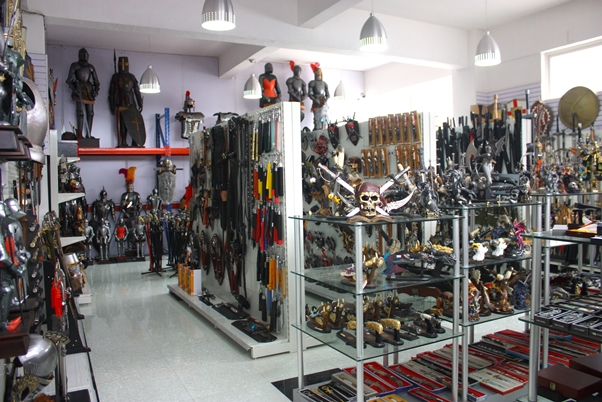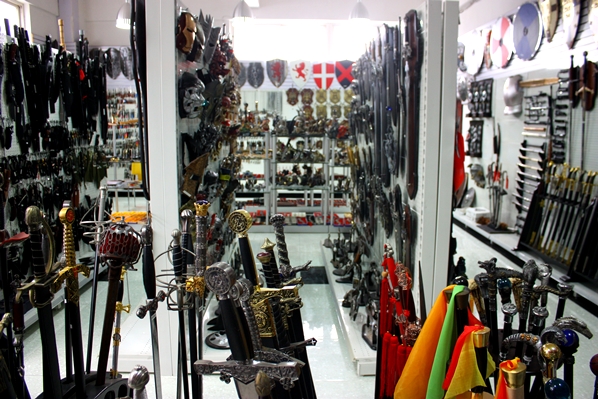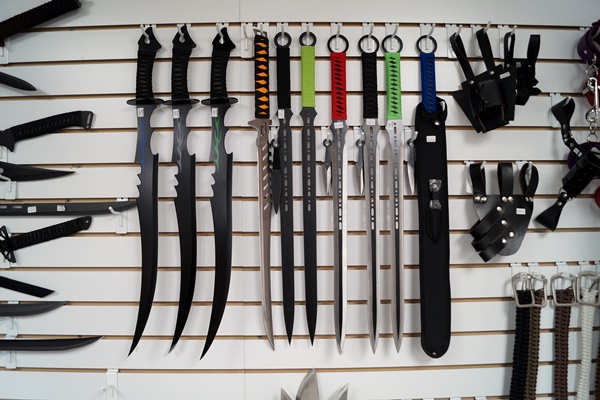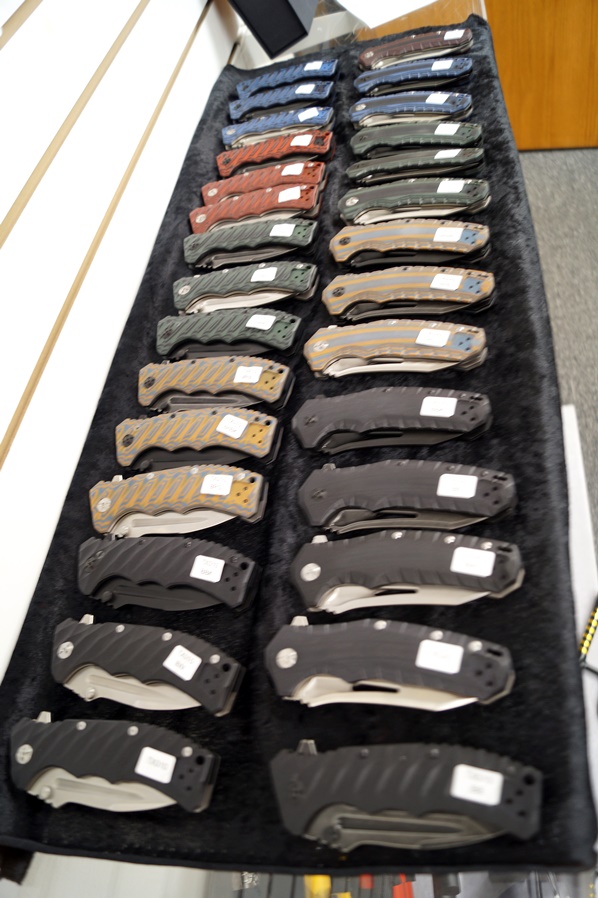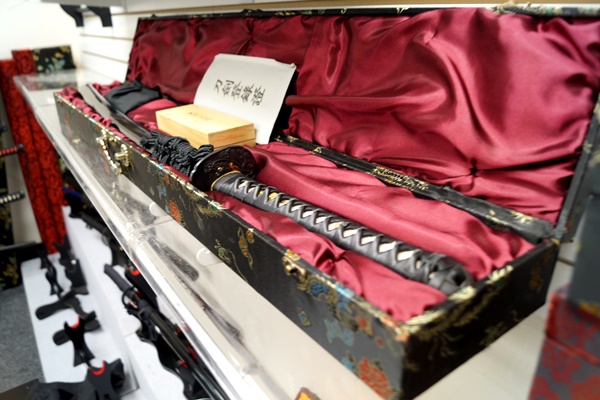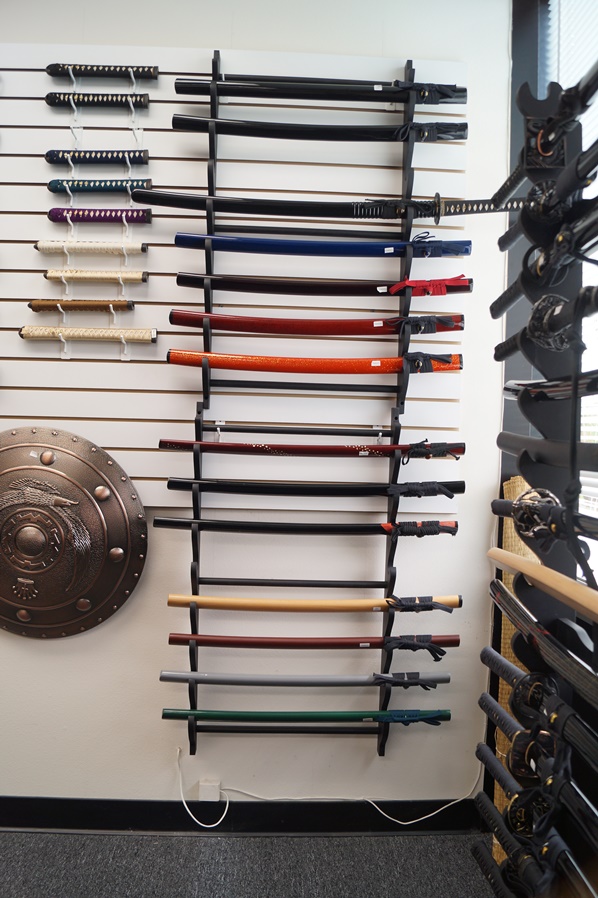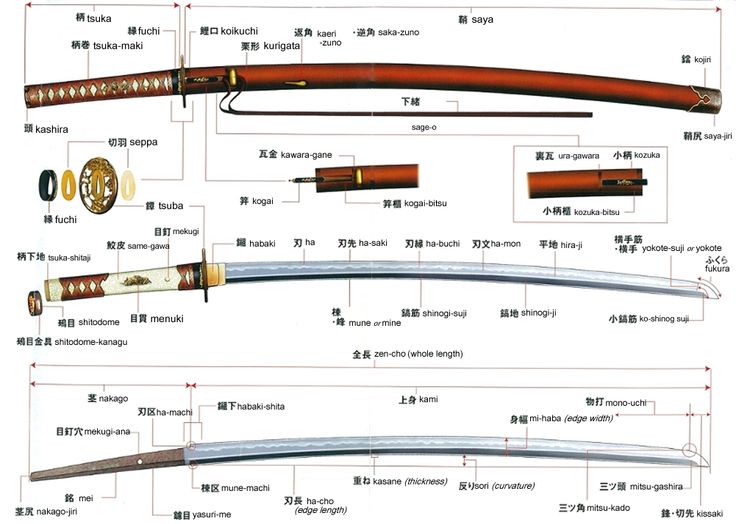Information about Swords & Weaponry
Product Introduction
We bring you the widest assortment of collectible samurai swords, medieval weapons, folding knives for hunting and survival, daggers, all types of weaponry as well as fantasy decoratives for your home or office. These are real knives and swords made of stainless steel. They are not toys and must be purchased with care. We have abundance of stocks and would ship them directly from our warehouse in the USA.
Show Room Overview
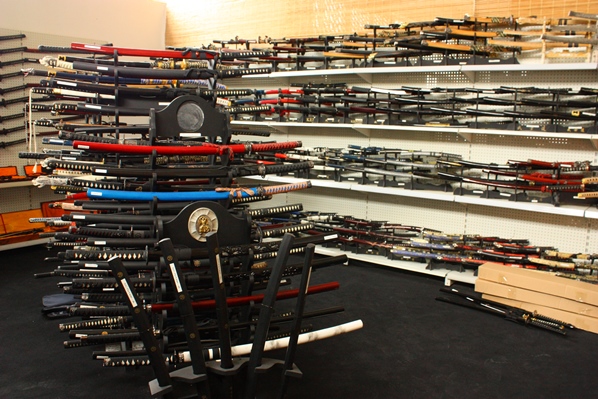
Quick Tips:
1. What is Samurai sword?
Samurai sword is a combating weapon used by military-nobility and officer-caste of medieval and early-modern Japan. From the earliest recorded times, the exceptional quality of Japanese swords has made them prized and admired. The care and technical skill that went into the creation of a samurai sword made the finished product not only a noteworthy weapon of war but also a cherished work of art. When Japanese daimyos met, they would admire each other’s collection of fine swords.
Samurai sword is also widely known as "Katana". It is characterized by its distinctive appearance: a curved, slender, single-edged blade with a circular or squared guard and long grip to accommodate two hands. The following are types of Samurai swords:
Chokutō (直刀?, "straight sword"): A straight single edged sword that was produced prior to the 10th century, and without differential hardening or folding.
Tsurugi/Ken (剣?, "sword"): A straight two edged sword that was produced prior to the 10th century, and may be without differential hardening or folding.
Tachi (太刀?, "big sword"): A sword that is generally longer and more curved than the later katana, with curvature centered from the middle or towards the tang, and often including the tang. Tachi were worn suspended, with the edge downward. The tachi was in vogue before the 15th century.
Kodachi (小太刀?, "small big sword"): A shorter version of the tachi, but with similar mounts and intended use, mostly found in the 13th century or earlier.
Ōdachi (大太刀?, "big big sword")/Nodachi (野太刀?, "big field sword"): Very large tachi, some in excess of 100 cm, and usually a blade of the late 14th century.
Uchigatana (打刀?): A development from the tachi in the 15th century. Worn with the edge upwards in the obi.
Katate-uchi (片手打ち?, "one handed"): A short type of uchigatana developed in the 16th century, with short tang, intended for one handed use. One of the forerunners of the wakizashi.
Katana (刀?, "sword"): A general term for the traditional sword with a curved blade longer than 60 cm (there is no upper length limit but generally they are shorter than 80 cm), worn with the edge upwards in the sash. Developed from the uchigatana and the sword of the samurai class of the Edo period (1600s to late 19th century).
2. Types of Steel that makes the Samurai Swords
This is a common question asked by beginners, but it is somewhat akin to asking 'how long is a piece of string' - mostly because 'best' depends on what type of sword we are talking about and what its intended usage is...
Not to mention that there are other factors that are actually more important than just the type of steel it is made from (for example, heat treatment and the quality of the forging is more important than the steel itself - a properly heat treated piece of the cheapest plain carbon steel is much better than than the best quality L6 tool steel if the blade is not tempered properly!).
So let's ask instead 'what are the different types of steel commonly used to make a sword - and what are their strengths and weaknesses' (when tempered properly of course!).
In this article, we will attempt to answer THIS question - and let you make up your own mind on what types of steel best suit YOUR preference (and budget) in a sword.
Stainless Steel
It used to be that just about every sword on the market was made from Stainless Steel. Now, it is almost only relegated to cheap decorative swords - and for good reason!
Stainless steel swords (or any blade over 12" long) is considered to be TOO brittle for serious usage and can shatter relatively easily (as demonstrated by the infamous 'home shopping video' below).
To get just a little technical with it - Stainless steel is 'stainless' because it has a high Chromium content (over 11%) - and when a blade gets over 12" long (such as a sword..) the grain boundaries between the chromium and the rest of the steel start to weaken, creating stress points. So the purpose of a sword made from stainless steel is to put it on the wall: and just keep it there to admire from a distance!
(High) Carbon Steel
At the very least, for a functional sword it has to be a (properly tempered) 'High Carbon steel sword'. But what exactly does this mean?
Generally, The American society of automotive engineers (SAE) scale is the one most commonly used by sword manufacturers. And the most commonly used steel for functional swords is plain carbon steel, which is designated by the first two digits 10 - and a number from 01 to 99 afterwards, with each point signifies that .01% of that steel is carbon.
For example, steel classified as AISI 1045 has 0.45% carbon content, 1060 is 0.60 carbon, etc.
Steels with a carbon content between 0.05 to 0.15 are considered to be LOW CARBON STEEL, and 0.16 to 0.29 MILD STEEL - neither of which are suitable for a functional sword (as any sword with a carbon content of less than 0.40% canÂ’t really be hardened and given a decent heat treatment, though mild steel can and often is used for fittings).
The most popular three types of carbon steel used in swords are 1045, 1060 and 1095, starting with the most inexpensive (1045) with most sword experts agree that the ideal range for a durable and sharp sword is somewhere between 0.5 and 0.7 carbon content.
1045 CARBON STEEL
1045 Carbon Steel swords are quite cheap to make because, being relatively soft, they are easy to make (either by hand forging, pressing or machine milling) but can be hardened, so are effectively the MINIMUM acceptable steel for a functional blade.
If well tempered, they can be surprisingly strong, and when you look at a sword under US$100, if it just says 'high carbon steel' - it is probably 1045... (and at this price, it is almost certainly machine milled).
1060 CARBON STEEL
1060 Carbon Steel is a great compromise between hardness (edge holding ability) and pliability (strength) - and many swords famous for their DURABILITY, such as those by Ronin Katana, Cold Steel and Darksword Armory, are made from 1060 carbon steel.
Consequentially, 1060 Carbon Steel swords are very popular, though because the steel is harder than 1045 - are more difficult to forge, shape and polish and thus almost always has a higher price tag.
Definitely a great all round steel that is hard enough to take and keep a good edge but focused primarily on it's durability.
1095 CARBON STEEL
1095 Carbon steel is very HARD - and unless it is properly heat treated, this hardness can sometimes be problematic when used on harder targets (either intentionally, or unintentionally - such as accidentally hitting a wooden stand).
The main advantage to swords made from 1095 carbon steel is that they can take and keep a much keener edge than swords with a lower carbon content. The disadvantage is that they can sometimes be a little on the brittle side - so durability is traded off for edge retention.
It doesn't mean that a sword made from 1095 carbon steel is exceptionally fragile, but it is simply no where near as TOUGH as the lower carbon content swords.
So it just depends on what you are looking for in a blade...
Spring Steels
For our purposes, there are basically two types of spring steel swords - 5160 and 9260. As with the plain carbon steel swords, the last two digits represent the carbon content - so both have .60% carbon and therefore, are like the 1060 carbon steel swords (a great compromise between hardness and durability) - and when properly heat treated, allows objects made of spring steel to return to their original shape despite significant bending or twisting, thus giving 1060 spring steel a special kind of 'twist'.
So let's take a look at these two different steel types:
5160 SPRING STEEL
5160 Spring Steel is a low Chromium alloy steel, with around 0.7 Chromium - which is not enough to make it stainless (which requires a minimum of 13% Chromium) - but combined with a small amount of silicon (0.2%) results in an extremely tough and durable sword and is favored by sword makers such as Angus Trim, Generation 2 and the blades designed by Michael Tinker Pearce and made by the Hanwei Forge.
5160 Spring Steel was also the steel of choice for the famous Nepalese Khurki - blades so tough and so sharp they are reportedly able to cut off a buffalos head with a single strike!
Again, what is critically important is the heat treatment - if it is applied wrong, even the best 5160 Spring Steel sword will take a set (Generation 2 had some issues with this way back in 2007), but when done properly - the end result is spectacular.
9260 SPRING STEEL
Made famous by Cheness Cutlery and also used by Australian Custom Sword Maker Brendon Olszowy from Fableblades - 9260 Spring Steel (also called Silicon Manganese Steel) consists of 2% silicon content, giving it an even more dramatic resilience against lateral bends and allowing it to spring back to true even after being bent almost to 90 degrees.
Swords made from 9260 Spring Steel have a reputation for durability - though like any blade they are not indestructible - and while rare, they can be broken or damaged. I've tested quite a few myself very hard and never had this happen, but I have heard of it occurring - and there is this video on youtube showing a "Konron forge" 9260 blade breaking against a thick bone (thicker than any human bone would be) - which would happen to almost any blade striking it - so they don't have magical powers that defy metallurgy or physics..! ;-)
The moral of the story is that no blade is indestructible - and because of the nature of what swords were originally designed to do, it is never a good idea to put yourself in a situation where you expose yourself to the potential of a blade snapping off and flying through the air anywhere near you...
TOOL STEEL
Tool steel swords have been quite popular in recent years, mostly because swords made from these steels are hard yet quite tough and tend to hold and keep a good edge. While there are several types on the market, there are two that everyone tends to be talking about - and those two are T-10 tool steel and the legendary L6 Bainite.
T-10 TOOL STEEL
T10 Tool Steel is a Tungsten alloy steel with a very high carbon content (around 0.9 to 1.0%) with a little bit of silicon (around .35% maximum) and is often referred to as 'High Speed Steel'.
This stuff tends to be very hard (above HRC60 when properly tempered) and the Tungsten means that it is also more resistant to scratches and abrasions than most other types of steels, plus considerably tougher than other swords with a similar level of carbon content.
While these swords are generally only seen on higher end production swords, the SBG Custom Katana and Ryujin Custom Katana series swords are made from T10 steel and as seen in the video above, hold their own quite well.
L6 BAINITE
L6 Bainite is also a tool steel (band saw steel actually), with the L designating it is a low alloy steel and - when properly heat treated, has a reputation as the TOUGHEST type of sword steel currently on the market - mostly due to the innovative custom sword work of Howard Clark, a smith for the Bugei Trading company who started producing this steel in the late 1990s.
While when properly heat treated (it can be a hard steel to work with) there is little argument that it is one of the toughest steels commercially available for swords, it can sometimes be prone to rust so needs plenty of maintenance, and of course, is quite expensive to make (no decently made L6 sword has a price tag of under US$1,000 - if you see it under this price point, run screaming!).
S7 SHOCK STEEL
As the name suggests, S7 Shock Steel is shock resistant and has many of the characteristics of L6 tool steel when properly heat treated - that is to say it is extremely tough, damage resistant and tough.
It is also comparatively rare and not commonly found on production swords, making it one of the most desirable sword steels around.
Again, it is not magical, nor is it indestructible, but it certainly outperforms most other sword steels. Especially the last one..
"Damascus" Steel/FOLDED STEEL
Many people often have questions about Damascus Steel, or folded steel, thinking that it is the best steel for swords - but in reality, what we currently call 'Damascus Steel' is just any of the steel types above that has been folded several times..
But even knowing this, many people are under the impression that layered or folded steel is somehow better than non folded steel and somehow makes the blade a better cutter or more durable...
However it simply isn't true!!
When referring to Japanese swords (as almost all questions about Damascus steel swords are referring to the Katana) - historically this technique was done to try and make Japanese iron ore (which was actually pretty poor quality) homogenous - something which, with the quality of modern steel, is no longer required.
In fact, folding when done quickly and without serious attention to detail actually WEAKENS a blade, sometimes fatally! This is especially true on swords sold under the $500 price point, and ALL the cheap ebay blades - most are riddled with air pockets, weak points and inclusions to the point that what could have been a decent sword if it was NOT folded is reduced to something even worse than a stainless steel sword..
Yes, you can get quiet functional ones - but they tend to be in the $800 plus price range. One of the better ones is made by the Imperial Forge and reviewed here - the review is insightful and shows the limits of what a folded steel sword can handle as well as discusses common folded sword steel myths and misnomers..
And even then they are still not quite as durable as a simple unfolded blade made from pure modern steel.. (but they look nicer - and are more traditional, so it just depends on what you like and your intended usage).

